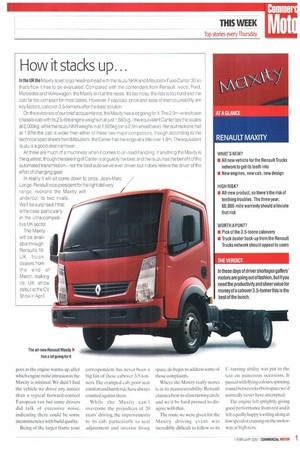From the Nissan Cabstar
Page 18

Page 19

If you've noticed an error in this article please click here to report it so we can fix it.
comes the Renault Maxity
Renault has stuck its badge on the Nissan Cabstar and re-named it the
Maxity. Andy Salter drives this stablemate for the Master and Mascot.
NEW ARRIVALS
RENAULT HAS EXTENDED its light delivery vehicle range with the Maxity. The new model, a rebadged Cabstar from Renault's sister company Nissan, is produced at 2.8-4.5 tonnes GVW and will only be available as a 3.5-tonner in the UK. It is aimed primarily at tradesmen and local authorities.
Like the Cabstar, the Maxity is powered by 2.5 or 3.0-litre diesels, rated at 110, 130 and 150hp with maximum torque of 250.270 and 350Nm respectively. Peak power is on tap at 3,600rpm (2.5-litre) or 3,40Orpm (3.0-litre);they all develop maximum torque at 1,60Orpm and feature the latest generation common-rail combustion technology. The bigger engine uses variable geometry turtxicharging.
Transmission choice is between five or six-speed manuals— there's no auto on the cards yet — with three rear-axle options covering a variety of applications. The shortest (4.11 1 :1) ratio is best suited to low-speed urban operations such as refuse collection. The rear axle in the 3.5-tonner is rated at 2,2(X)kg while the front capacity is 1.750kg, giving a decent amount of loading tolerance.
Braking is by discs all round. featuring ABS and EBD (electronic brake distribution). The Maxity also features EHS (easy hill start) which uses the electronics to apply the brakes on a hill without having to use the parking brake or foot brake.
The compact cab measures 1.87m wide by I .75m deep and 2.14m high, but there's a surprising amount of space inside. The interior has been dramatically revised from the previous Nissan Cabstar range; it employs sturdy materials and switchgear. Experience of the Nissan Cabstar has shown us this engine is noisy when cold; something which clearly hadn't escaped the attention of the Renault engineers when organising the ride-and-drive launch in France. Rather than allowing the press to start the engines from cold and experience the distinctive engine clatter, those kind folk had already started the engines for us, "It's rather cold, so we thought we'd warm the trucks for you," the demo manager explained, with a straight face. You're too kind...
In fairness this cold clatter soon goes as the engine warms up, after which engine noise intrusion in the Maxity is minimal. We didn't find the vehicle we drove any noisier than a typical forward-control European van but some drivers did talk of excessive noise, indicating there could be some inconsistencies with build quality Being of the larger frame your correspondent has never been a big fan of these cabover 3.5-tonners. The cramped cab, poor seat comfort and harsh ride have always counted against them.
While the Maxity can't overcome the prejudices of 20 years' driving, the improvements to its cab, particularly to seat adjustment and interior living space. do begin to address some of those complaints.
Where the Maxity really scores is in its manoeuvrability. Renault claims a best-in-class turning circle and we'd he hard pressed to disagree with that.
The route we were given for the Maxity driving event was incredibly difficult to follow so its U-turning ability was put to the test on numerous occasions. It passed with flying colours, spinning round between kerbs in space we'd normally never have attempted.
The engine felt sprightly, giving good performance from rest and it felt equally happy tootling along at low speed or cruising on the motorway at high revs.


























































































































































































